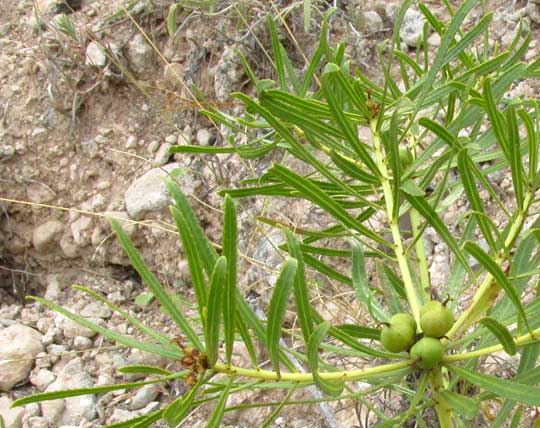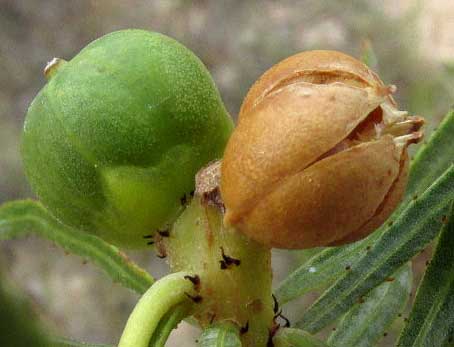Excerpts from Jim Conrad's
Naturalist Newsletter
from the August 31, 2014 Newsletter issued from the Frio Canyon Nature Education Center in the valley of the Dry Frio River in northern Uvalde County, southwestern Texas, on the southern border of the Edwards Plateau; elevation ~1750m (~5750 ft); N29.62°, W99.86°; USA
TEXAS TOOTHLEAF
In an arroyo bank's rocky soil in the upper Dry Frio floodplain where dog-days heat and the multi-year drought had stunned most wildflowers into crisp, brown submission, one tough, knee-high plant caught my attention not only with its bright greenness but also by its stems' unusual, branching-from-the-top form, shown below:

There you can see last year's dead stems at the plant's base, so this is clearly a perennial. Up closer we see that at stem tops not only does multiple branching occur, but also where all the branches originate, there are immature, pea-sized fruits, as shown below:

At the tip of some branches, spikes of much reduced male flowers may be accompanied at the spikes' bases by female flowers, as seen below:

In that picture notice that leaf margins bear many glandular "teeth." Also, beneath the green ovary or immature fruit at the image's lower, left, notice the yellowish, bowl-like, pollinator-attracting nectar gland. Moreover, if you look closely, you can see that each cluster of stamens on the spike also arises next to nectar glands, though smaller ones.
Notice that the fruits have three rounded corners. The vast majority of dicot fruits, if not round in cross section, are four or five angled, so this is a significant field mark. A shot of a mature fruit beginning to split open appears below:

A broken-apart capsular fruit with one of its white seeds is shown below:

So, here we have a plant that produces three-cornered fruits, separate male and female flowers on the same plant, and it's very glandular. If you break a leaf of this plant, a milky latex exudes from the wound, too. In other words, of what family could this plant belong other than the big, mostly tropical Spurge or Euphorbia Family, the Euphorbiaceae? Even in the Temperate Zone, when you see three-sided fruits like that on a dicot, the first family to think of is the Spurge Family.
However, unlike last week's spurge species where male and female flowers crammed together in a tiny, cuplike cyathium, the flowers of this week's member of the family are much larger and separated from another, so our arroyo-bank plant isn't a spurge itself, but rather a member of a different genus in the Spurge Family.
Once we know we have a member of the Spurge Family, the main field marks directing us to the right genus include:
In Texas these traits suffice to distinguish our plant as a member of the genus Stillingia, in which about 30 species are recognized, all occurring in tropical and semitropical parts of the Americas, with a handful of species extending north into the US southern states. Species of Stillingia often are referred to as toothleafs because of the toothy glands along the leaves' margins. Three Stillingia species can be found in Texas, but only one of those produces such narrow leaves as are shown in our picture, and that's STILLINGIA TEXANA, variously known as Texas Toothleaf, Queen's Delight and Texas Queen's Delight. Texas Toothleaf occurs almost exclusively in Texas, though it's been found spottily in Oklahoma, New Mexico and across the river in Coahuila State, Mexico.
I can't find why toothleafs are so delightful to queens, but another name used for one or more Stillingia species is Cockup Hat, so to certain people there must be something particularly alluring about these plants.
Members of the Spurge family are famous for their juices containing toxic or medicinal compounds, depending on the dosage, and toothleafs have long been regarded both as potentially poisonous for grazing livestock, and as powerful medicinal herbs. The plants are so unpalatable that usually livestock won't eat them, except when food is hard to find. Then if the plant is eaten its cyanogenic glycosides might release free cyanide into an animal's rumen, and you know how deadly cyanide is.
The WbMD.Com website says that "Despite serious safety concerns, people take queen's delight to treat liver disease, gallbladder disorders, skin diseases, constipation, bronchitis, and hoarseness (laryngitis)." It's also been used to induce vomiting and as a "blood purifier."